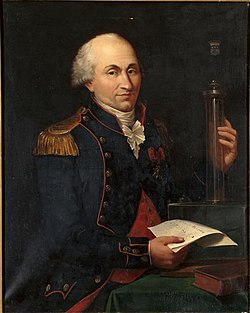Charles-Augustin de Coulomb
| Charles-Augustin de Coulomb | |
|---|---|

Portrait by Hippolyte Lecomte
|
|
| Born |
14 June 1736 Angoulême, Angoumois, France |
| Died | 23 August 1806 (aged 70) Paris, France |
| Nationality | French |
| Fields | Physics |
| Known for | Coulomb's law |
Charles-Augustin de Coulomb (French: [kulɔ̃]; 14 June 1736 – 23 August 1806) was a French physicist. He was best known for developing Coulomb's law, the definition of the electrostatic force of attraction and repulsion, but also did important work on friction. The SI unit of electric charge, the coulomb, was named after him.
Charles Augustin de Coulomb was born in Angoulême in France. He was born in a small home near France de Revone where he was raised for 7 years before beginning his education. His parents were Henry Coulomb and Catherine Bajet. He went to school in the Collège Mazarin in Paris where his father lived. His studies included philosophy, language and literature. He also received a good education in mathematics, astronomy, chemistry and botany.
Coulomb graduated in November 1761 from École royale du génie de Mézières. Over the next twenty years, he was posted to a variety of locations where he was involved in engineering - structural, fortifications, soil mechanics, as well as other fields of engineering. His first posting was to Brest but in February 1764 he was sent to Martinique, in the West Indies, where he was put in charge of building the new Fort Bourbon and this task occupied him until June 1772.
On his return to France, Coulomb was sent to Bouchain. However, he now began to write important works on applied mechanics and he presented his first work to the Académie des Sciences in Paris in 1773. In 1779 Coulomb was sent to Rochefort to collaborate with the Marquis de Montalembert in constructing a fort made entirely from wood near Ile d'Aix. During his period at Rochefort, Coulomb carried on his research into mechanics, in particular using the shipyards in Rochefort as laboratories for his experiments.
Upon his return to France, with the rank of Captain, he was employed at La Rochelle, the Isle of Aix and Cherbourg. He discovered first an inverse relationship of the force between electric charges and the square of its distance and then the same relationship between magnetic poles. Later these relationships were named after him as Coulomb's law.
...
Wikipedia
